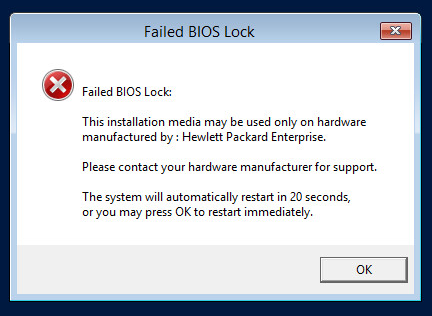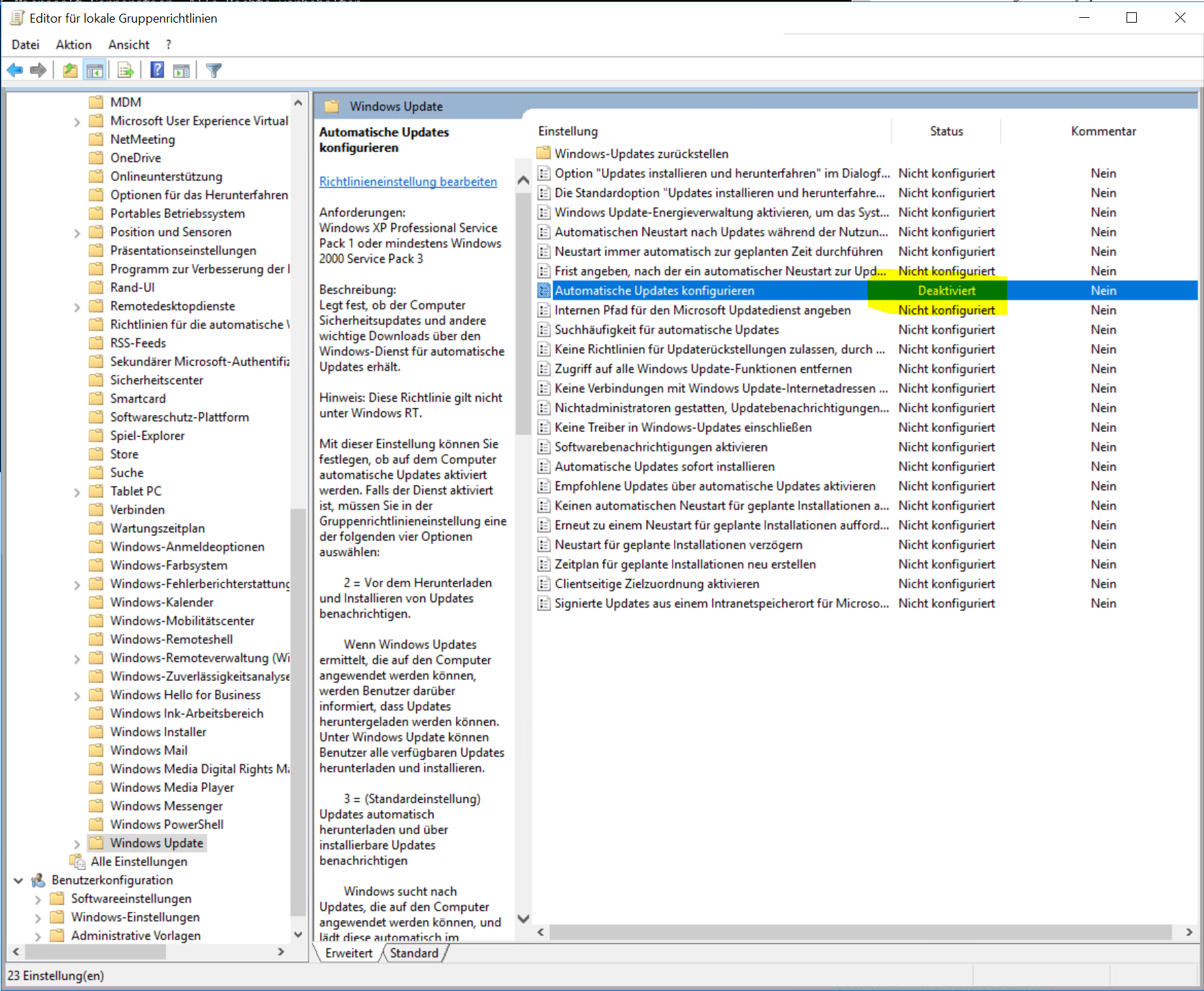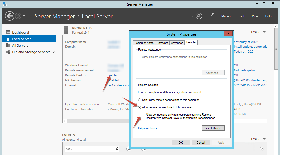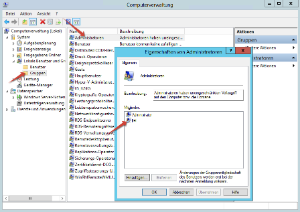Unterstützte Supported Windows Versionenversions| Version | Unterstützt | Empfehlung |
|---|
| Windows Server 2008 | NeinNo |
| | Windows Server 2008 R2 | Ja | Yes | Do not use for new installations.
Schedule update to new versionBei Neuinstallationen nicht mehr nutzen.
Update auf neue Version einplanen. | | Windows Server 2012 | NeinNo |
| | Windows Server 2012 R2 | Ja | Yes | Do not use for new installations.
Schedule update to new versionBei Neuinstallationen nicht mehr nutzen.
Update auf neue Version einplanen. | | Windows Server 2016 | NeinNo |
| | Windows Server 2016 R2 | JaYes |
| | Windows Server 2019 | JaYes |
HinweisNoteTo install the SIP drivers under Für die Installation der SIP Treiber unter Windows Server 2016 R2 sowie and Windows Server 2019 muss das sogenannte , the so-called Secure Boot deaktiviert werden. Hinweise wie dies geschehen kann finden Sie bei der Dokumentation Ihrer jeweiligen virtuellen Umgebung. Aufheben vom BIOS Lock bei OEM Versionen von Windows ServerManchmal bei der Installation in VMWare mit Nutzung eines Images von einer OEM Version von Windows Server, kann ein Fehler entstehen, ungefähr so:  Image Removed Image Removed
must be deactivated. See the documentation of your virtual environment for instructions on how to do this. Removing the BIOS lock on OEM versions of Windows ServerSometimes when installing in VMWare using an image from an OEM version of Windows Server, an error may occur, like this:  Image Added Image Added
To fix this, do the followingUm dieses zu beheben, folgendes machen: | Translations Ignore |
|---|
| Code Block |
|---|
With VSphere Client installed navigate to the VM and edit settings.
From the "Options" tab navigate to Advanced and click General.
Configure Parameters on the right and add a new row to the parameters called "smbios.ReflectHost" with a value of "true."
Do this with the VM off, if it's on then restart the VM.
Lock is lifted. |
|
Proxy ServerManche Anwendungen (beispielsweise GIT) benötigen die explizite Angabe eines Proxies. Some applications (such as GIT) require the explicit specification of a proxy. This can be determined with the following command if the settings are automaticDies kann mit folgenden Befehl ermittelt werden, falls die Einstellungen automatisch sind: | Translations Ignore |
|---|
| Code Block |
|---|
netsh winhttp show proxy |
|
Grundinstallation des Betriebssystems Die Installation von Windows Server erfolgt ohne besondere Vorkehrungen oder Anpassungen von einer Installations-DVD bzw. ISO-Datei. Achtung: die Version MIT Grafische Oberfläche muss installiert werden. Während der Installation wird das System mehrmals neu gestartet. Nach Fertigstellung der Installation verlangt das System in der Regel nach einem Passwort für den lokalen Administrator Benutzer. Ist dies festgelegt, befindet man sich im normalen Desktop. Da die Installationsroutine keine große Einstellungen erlaubt, wurden verschiedene gängige Merkmale bereits automatisch eingestellt: - Rechnername: Es wurde ein Hostname automatisch erzeugt.
- Netzwerkkonfiguration: Der Windows-Installer konfiguriert die gefunden Netzwerkkarten automatisch mit DHCP. Steht ein DHCP Server zur Verfügung, so ist das installierte Windows unter einer dynamisch zugewiesenen Adresse erreichbar. Steht ein solcher nicht zur Verfügung, so muss der Netzwerkadapter so konfiguriert werden, dass er unter einer bekannten Adresse im Netzwerk funktionsfähig ist.
Windows UpdatesBitte solange Windows Updates durchführen, bis wirklich keine Updates mehr gefunden werden. Sollte dies vom Projekt-Techniker durchgeführt werden müssen, stellt dies ein Mehraufwand dar!
Basic installation of the operating system Windows Server is installed from an installation DVD or ISO file without any special precautions or adjustments. Attention: the version WITH graphical user interface must be installed. During the installation the system is rebooted several times. After the installation is complete, the system usually asks for a password for the local administrator user. If this is set, you are in the normal desktop. Since the installation routine does not allow large settings, several common features have already been set automatically: - Host name: A host name was generated automatically.
- Network configuration: The Windows installer automatically configures the found network cards with DHCP. If a DHCP server is available, the installed Windows can be reached under a dynamically assigned address. If no such address is available, the network adapter must be configured so that it can function under a known address on the network.
Windows Updates- Please keep updating Windows until no more updates are found.
- Should this have to be carried out by the project technician, this represents additional work.
- Afterwards, automatic Windows updates should be switched off.
- On Windows Server 2012 R2, the setting is available via "Windows Updates" and can be easily clicked.
- Under Windows Server 2016 this option is more hidden.
Press Windows + R and enter gpedit.msc.
Then navigate to the following branch:
Computer configuration ... Administrative Templates ... Windows-Components ... Windows Update. Here, deactivate the option accordingly.
 Image Added Image Added
Requirements for the handover to the project technicianThe following settings must now be made on the Windows machine: - Set the host name of the system.
- Set IP address, netmask, default gateway and DNS server. Address must be static or a reservation in DHCP must be available.
- If desired by the customer, add computers to the domain (requires an appropriately authorized domain account and a restart) Must be done in cooperation with the client administrator if necessary.
- Activate Remote Desktop. This can be done via the Server Manager:
 Image Added Image Added - Create local JTEL user and add it to the local administrator group. This can be done via the computer administration:
 Image Added Image Added
ATTENTION: If the customer insists that the jtel programs are run under a domain account because e.g. company or domain policies do not allow local Windows users, this account must be given administrator rights on this specific server. It must therefore be included in the local administrator group. Within the domain, this account needs no further rights. - For virtual machines: Installing the Guest Tools (i.e
Anschließend, sollten automatische Windows Updates ausgeschaltet werden. Unter Windows Server 2012 R2 ist die Einstellung über "Windows Updates" verfügbar und kann einfach angeklickt werden.Unter Windows Server 2016 ist diese Option weiter versteckt.
Windows + R drücken, und gpedit.msc eingeben.
Dann zu folgenden Zweig navigieren:
Computerkonfiguration ... Administrative Vorlagen ... Windows-Komponenten ... Windows Update. Hier die Option entsprechend ausschalten.
 Image Removed Image Removed
Voraussetzungen für die Übergabe an den Projekt-TechnikerFolgende Einstellungen müssen nun auf der Windows-Maschine getätigt werden: - Hostname des Systems einstellen.
- IP Adresse, Netzmaske, Standardgateway und DNS Server einstellen. Adresse muss statisch sein oder eine Reservierung im DHCP muss vorliegen.
- Falls vom Kunden gewollt, Rechner der Domäne hinzufügen (erfordert einen entsprechend berechtigten Domänen-Account und einen Neustart). Muss gegebenenfalls in Zusammenarbeit mit dem Kundenadministrator erfolgen.
- Remote Desktop aktivieren. Dies kann über den Server Manager erledigt werden:
 Image Removed Image Removed - Lokalen JTEL-Benutzer erzeugen und in die lokale Administrator-Gruppe aufnehmen. Dies kann über die Computer-Verwaltung erledigt werden:
 Image Removed Image Removed
ACHTUNG: Sollte der Kunde darauf bestehen, dass die jtel-Programme unter einem Domänen Account ausgeführt werden weil z.B. die Unternehmens- bzw. Domänen-Richtlinien keine lokale Windows-Benutzer zulassen, so muss dieser Account Administrator-Rechte auf diesem spezifischen Server erhalten. Dieser muss also in der lokalen Administrator Gruppe aufgenommen werden. Innerhalb der Domäne braucht dieser Account keine weiteren Rechte. - Bei virtuellen Maschinen: Installation der Guest Tools (z.B.: VMware Tools, Hyper-V Integration Services, etc.)
- Alle Install all Windows Updates installierenupdates
TestsNach einem Neustart sollte nun folgendes geprüft werden: - Das System ist über RDP erreichbar.
- Es ist für den Projekt-Techniker möglich, sich über einen Remote Desktop Client als jtel-Benutzer an das System anzumelden.
- Der Projekt-Techniker kann in einer solchen Sitzung einen Prozess als Administrator starten.
Installiert der Kunde die Betriebssysteme, so ist dies üblicherweise der Übergabepunkt an den Projekt-Techniker. Anpassung des BetriebssystemsAfter a restart the following should now be checked: - The system is accessible via RDP.
- It is possible for the project technician to log on to the system as a jtel user via a remote desktop client.
- The project technician can start a process as administrator in such a session.
If the customer installs the operating systems, this is usually the handover point to the project technician. Adaptation of the operating systemThe following further adjustments are now carried out on the Windows machine by the project technicianFolgende weitere Anpassungen erfolgen nun auf der Windows Maschine durch den Projekt-Techniker: - Java
- https://cdn.jtel.de/downloads/java/jdk-8u202-windows-x64.exe
- Compiler -BibliothekenLibraries
- https://cdn.jtel.de/downloads/redist/vcredist_9.0_x86_9.0.30729.4148.exe
- https://cdn.jtel.de/downloads/redist/vcredist_2010_x86_10.0.30319.exe
- https://cdn.jtel.de/downloads/redist/vcredist_2012_x64_11.0.61030.exe
- https://cdn.jtel.de/downloads/redist/vcredist_2012_x86_11.0.61030.exe
- https://cdn.jtel.de/downloads/redist/vcredist_2015_x64_14.0.24123.exe
- https://cdn.jtel.de/downloads/redist/vcredist_2015_x86_14.0.24123.exe
- https://cdn.jtel.de/downloads/redist/vcredist_2017_x64_14.16.27027.exe
- https://cdn.jtel.de/downloads/redist/vcredist_2017_x86_14.16.27027.exe
- https://cdn.jtel.de/downloads/redist/ww_icl_redist_ia32_2017.1.143.msi
- https://cdn.jtel.de/downloads/redist/ww_icl_redist_intel64_2017.1.143.msi
- Cygwin Umgebung. Die Installation erfolgt in mehreren SchrittenCygwin environment. The installation is done in several steps:
- https://www.cygwin.com/setup-x86_64.exe
- "Install from Internet"
- ZielverzeichnisTarget directory: C:\Cygwin
- Package directory:
C:\Cygwin\packages - Select Packages:
openssh (Bereich Area "Net")
ncftp (Bereich Area "Net")
curl (Bereich Area "Net")
wget (Bereich Area "Web")
- Git Pre-Requisites:
- https://cdn.jtel.de/downloads/tools/Git-2.16.2-64-bit.exe
WICHTIGIMPORTANT: DO NOT install Git Credential Manager NICHT installieren
- GIT Client:
- https://cdn.jtel.de/downloads/tools/TortoiseGit-2.6.0.0-64bit.msi
Name: jtel Support
E-Mailemail: support@jtel.de
- Text -Editor editor Notepad++
https://cdn.jtel.de/downloads/tools/npp.7.5.6.Installer.exe
- MySQL ODBC Connector:
HINWEIS: Wegen Speicher-Probleme in den neueren MySQL Treibern wird empfohlen, mit der Version NOTE: Due to memory problems in the newer MySQL drivers, it is recommended to work with version 5.2.7 zu arbeiten. Auch in den neuesten 7 Even in the latest 8.x ODBC Treibern treten Speicherprobleme auf, wenn Verbindungen zu der Datenbank abbrechendrivers, memory problems occur when connections to the database fail.
- https://cdn.jtel.de/downloads/tools/mysql-connector-odbc-5.2.7-win32.msi
- Google Chrome:
- (Englisch) https://www.google.com/chrome/browser/desktop/index.html?system=true&standalone=1&platform=win64&hl=en
- (Deutsch) https://www.google.com/chrome/browser/desktop/index.html?system=true&standalone=1&platform=win64&hl=de
- Windows Explorer Einstellungensettings:
- Explorer starten start explorer(Win+E)
- "Ansicht " bzw. "View" ... "Optionen" bzw. "Options"
- "Alle Ordner anzeigen" bzw. activate "Show all folders" aktivieren
- "Dateinamenerweiterungenactivate " bzw. "File name extensions" aktivieren
- CMD Einstellungensettings:
- chose "Defaults" bzw. "Defaults" wählen
- deactivate "Quick edit mode" This must be done so that services running as cmd are not interrupted by a mouse click"Quick-Edit Modus" deaktivieren. Dies muss sein, damit Dienste die als cmd laufen nicht durch ein Mausklick unterbrochen werden.
- "Layout" die beiden Werte "Breite" auf 125 einstellen. set the two "width" values to 125
- "Layout" den Wert set the "Höhe" im Bereich "Fenstergröße" auf 50 einstellen
Alle Downloads- Height" value in the "Window size" area to 50
All downloads| Translations Ignore |
|---|
| Code Block |
|---|
| https://cdn.jtel.de/downloads/java/jdk-8u202-windows-x64.exe
https://cdn.jtel.de/downloads/redist/vcredist_9.0_x86_9.0.30729.4148.exe
https://cdn.jtel.de/downloads/redist/vcredist_2010_x86_10.0.30319.exe
https://cdn.jtel.de/downloads/redist/vcredist_2012_x64_11.0.61030.exe
https://cdn.jtel.de/downloads/redist/vcredist_2012_x86_11.0.61030.exe
https://cdn.jtel.de/downloads/redist/vcredist_2015_x64_14.0.24123.exe
https://cdn.jtel.de/downloads/redist/vcredist_2015_x86_14.0.24123.exe
https://cdn.jtel.de/downloads/redist/vcredist_2017_x64_14.16.27027.exe
https://cdn.jtel.de/downloads/redist/vcredist_2017_x86_14.16.27027.exe
https://cdn.jtel.de/downloads/redist/ww_icl_redist_ia32_2017.1.143.msi
https://cdn.jtel.de/downloads/redist/ww_icl_redist_intel64_2017.1.143.msi
https://www.cygwin.com/setup-x86_64.exe
https://cdn.jtel.de/downloads/tools/Git-2.16.2-64-bit.exe
https://cdn.jtel.de/downloads/tools/TortoiseGit-2.6.0.0-64bit.msi
https://cdn.jtel.de/downloads/tools/npp.7.5.6.Installer.exe
https://cdn.jtel.de/downloads/tools/mysql-connector-odbc-5.2.7-win32.msi
(Englisch)
https://www.google.com/chrome/browser/desktop/index.html?system=true&standalone=1&platform=win64&hl=en
(Deutsch)
https://www.google.com/chrome/browser/desktop/index.html?system=true&standalone=1&platform=win64&hl=de |
|
Wenn Chrome installiert und als Standardbrowser eingerichtet ist, können Sie folgende Befehle nutzen um alle Downloads (bis auf Chrome) automatisch zu starten: If Chrome is installed and set as your default browser, you can use the following commands to automatically start all downloads (except Chrome) | Translations Ignore |
|---|
| Code Block |
|---|
start https://cdn.jtel.de/downloads/java/jdk-8u202-windows-x64.exe
start https://cdn.jtel.de/downloads/redist/vcredist_9.0_x86_9.0.30729.4148.exe
start https://cdn.jtel.de/downloads/redist/vcredist_2010_x86_10.0.30319.exe
start https://cdn.jtel.de/downloads/redist/vcredist_2012_x64_11.0.61030.exe
start https://cdn.jtel.de/downloads/redist/vcredist_2012_x86_11.0.61030.exe
start https://cdn.jtel.de/downloads/redist/vcredist_2015_x64_14.0.24123.exe
start https://cdn.jtel.de/downloads/redist/vcredist_2015_x86_14.0.24123.exe
start https://cdn.jtel.de/downloads/redist/vcredist_2017_x64_14.16.27027.exe
start https://cdn.jtel.de/downloads/redist/vcredist_2017_x86_14.16.27027.exe
start https://cdn.jtel.de/downloads/redist/ww_icl_redist_ia32_2017.1.143.msi
start https://cdn.jtel.de/downloads/redist/ww_icl_redist_intel64_2017.1.143.msi
start https://www.cygwin.com/setup-x86_64.exe
start https://cdn.jtel.de/downloads/tools/Git-2.16.2-64-bit.exe
start https://cdn.jtel.de/downloads/tools/TortoiseGit-2.6.0.0-64bit.msi
start https://cdn.jtel.de/downloads/tools/npp.7.5.6.Installer.exe
start https://cdn.jtel.de/downloads/tools/mysql-connector-odbc-5.2.7-win32.msi |
|
Sicherstellen der Namensauflösung
Ensuring name resolutionSince it is not necessarily to be expected that all computer names and IP addresses can always be reliably resolved in both directions by the customer's DNS servers (often the customer has no idea how to manage this), the host file on each of the machines of the jtel system should also be adapted accordingly so that all machines of the system are known. To do this, the fileDa nicht unbedingt damit zu rechnen ist, dass alle Rechnernamen und IP Adressen zuverlässig durch die DNS Server des Kunden immer in beiden Richtungen aufgelöst werden können (oft hat der Kunde keine Ahnung, wie er das verwalten soll), sollte auf jede der Maschinen des jtel-Systems auch die Hostdatei entsprechend angepasst sein, dass alle Maschinen des Systems dadurch bekannt sind. Dafür muss die Datei C:\Windows\System32\drivers\etc\hosts als Administrator editiert werden. Das könnte dann so aussehen must be edited as administrator. It could look like this: | Translations Ignore |
|---|
| Code Block |
|---|
| title | C:\Windows\System32\drivers\etc\hosts |
|---|
| # Copyright (c) 1993-2009 Microsoft Corp.
#
# This is a sample HOSTS file used by Microsoft TCP/IP for Windows.
#
# This file contains the mappings of IP addresses to host names. Each
# entry should be kept on an individual line. The IP address should
# be placed in the first column followed by the corresponding host name.
# The IP address and the host name should be separated by at least one
# space.
#
# Additionally, comments (such as these) may be inserted on individual
# lines or following the machine name denoted by a '#' symbol.
#
# For example:
#
# 102.54.94.97 rhino.acme.com # source server
# 38.25.63.10 x.acme.com # x client host
# localhost name resolution is handled within DNS itself.
# 127.0.0.1 localhost
# ::1 localhost
192.168.1.10 acd-lb acd-lb.example.com
192.168.1.10 acd-store acd-store.example.com
192.168.1.21 acd-dbm acd-dbm.example.com
192.168.1.22 acd-dbs acd-dbs.example.com
192.168.1.22 acd-dbr acd-dbr.example.com
192.168.1.31 acd-jb1 acd-jb1.example.com
192.168.1.32 acd-jb2 acd-jb2.example.com
192.168.1.40 acd-tel1 acd-tel1.example.com |
|
| 


